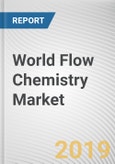Besides all facts, this market has enormous potential in Biodiesel, Fuels, Food, Beverage and Other Industries. In addition to that, it has a huge market in Middle East, especially in chemical and petrochemical industry.
Flow Chemistry Market Analysis by Product Types
By the product type, flow chemistry market is segmented into Plug Flow Reactors (PFR), Micro Reactor systems (MRT),), Microwave systems and Continuous Stirred Tank Reactors (CSTR. The market for MRT systems is driven by the fact that, it has a lot of energy saving potential and is safe in operation, as reactions takes place within the micro channels, which is comparatively lesser in other type of reactors.
Flow Chemistry Market Analysis by Application
Based on the application, the Flow chemistry market is segmented into Chemicals, Pharmaceuticals, Petro Chemicals, Bio fuels, Perfume & Fragrance Industries, Academia research and laboratories. Flow Chemistry becomes an important tool for new drug development in Pharmaceuticals.
Flow Chemistry Market Analysis by Geography:
Based on geography, the flow chemistry market is segmented into North America, Europe, Asia- Pacific and rest of the world. Europe is the largest market for almost all reactors, except for microwave systems; however, U.S. is the largest buyer of microwave systems due to ongoing lab scale projects. Asia Pacific region is the upcoming market for continuous flow reactors due to the infrastructural opportunities present in the region. Flow chemistry is primarily used in chemical and pharmaceutical industries due its wide area of applications.
Competitive Analysis:
The major players dominating this market are Syrris, Little Things Factory, ThalesNano, IMM, Chemtrix, DSM, AM Tech U.K, Uniqsis, Future Chemistry, Lonza, YMC, etc. Syrris has launched ‘Asia Tube Cooler’, the latest addition to the Company’s range of advanced flow chemistry products. Product launch is one of the important strategies adopted by the companies to increases their market share.
High level Analysis:
This study is an overall view on global flow market analysis, which is growing rapidly due to the rising demand for sustainable equipment. In addition to that, this process is energy saving, safe and flexible. The major concern for this market growth is its high production cost. However, this analysis is emphasizing more towards its usages in all growing sectors such as biodiesel, fuels, food, and beverage, chemical and petrochemical industry. This study presents an in-depth intelligence of key patents granted and also emphasizes on key intermediaries involved in flow chemistry market through value chain analysis. Porter’s five force model helps to understand bargaining power of suppliers, buyers, and competitive rivalry in an
Methodology
The analyst offers exhaustive research and analysis based on a wide variety of factual inputs, which largely include interviews with industry participants, reliable statistics, and regional intelligence. The in-house industry experts play an instrumental role in designing analytic tools and models, tailored to the requirements of a particular industry segment. The primary research efforts include reaching out participants through mail, tele-conversations, referrals, professional networks, and face-to-face interactions.
They are also in professional corporate relations with various companies that allow them greater flexibility for reaching out to industry participants and commentators for interviews and discussions.
They also refer to a broad array of industry sources for their secondary research, which typically include; however, not limited to:
- Company SEC filings, annual reports, company websites, broker & financial reports, and investor presentations for competitive scenario and shape of the industry
- Scientific and technical writings for product information and related preemptions
- Regional government and statistical databases for macro analysis
- Authentic news articles and other related releases for market evaluation
- Internal and external proprietary databases, key market indicators, and relevant press releases for market estimates and forecast
Furthermore, the accuracy of the data will be analyzed and validated by conducting additional primaries with various industry experts and KOLs. They also provide robust post-sales support to clients.

LOADING...








